Premium
A nation in crisis: Widespread devastation as El Niño unleashes catastrophic floods
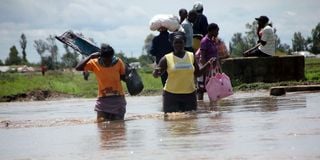
Residents of Ombeyi village in Ahero move to safer ground after their homes were flooded by heavy El Niño rains.
Cyril Nangalama watches and contemplates deeply on the flood water that has become a common sight in his Ongata Rongai area. This is the worst flooding he has witnessed in a long time and worries that the roads in the region will be rendered impassable if the rainfall continues.
His worst fears are materialising as drainage channels in the area clog up with trash as stormwater carries more trash and debris from different areas upstream.
“I expected the early warnings of heavy rainfall would jolt the local government to start clearing drainage infrastructure. However, rains from the past few days have dragged in plastics and other solid waste, making it impossible for the existing drainage system to work,” he laments.

A motorist crosses Kalemngorok seasonal river on the Kainuk-Lokichar-Lodwar road in Turkana on County on November 19, 2023.
Jane Wairimu Kiruru, says the El Niño-enhanced rains have changed her work schedule. Jane, who runs a vegetable stall, says it’s no longer easy for her to reach the nearby Quarry Market owing to myriad ditches flowing with wastewater.
“My business depends on me rising early to get to Quarry in time to pick the freshest produce. The ongoing rains have changed that. These days I have to wait until there’s sufficient daylight since I cannot risk walking in those waters,” she explains.
In Mombasa County, residents from Hadija estate in Nyali sub-county are worried as rainwater floods their homes, rendering them inhabitable. Last week, a man died from injuries sustained following a landslide in the region.
“We have lived here these past 23 years and it is sad that we cannot get any help. Can the county and national government intervene? We have suffered losses. My TV set, seats have been destroyed and we relocated the fridge because our house is flooded,” says Eugene Lubangi.
Lubangi also accuses a local businessperson whose wall is blocking the waterway, claiming that the sewerage system no longer directs and empties flood water as it used to.
He adds, “We are asking our brother to open up the infrastructure because we have been having this problem as a result of that wall [of his]. The county government is aware of our predicament, but it seems like those officials in charge are friends with the owner of the yard.”
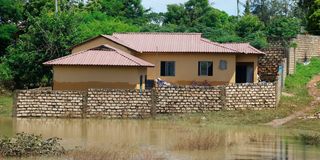
A marooned house in the Utange area of Mombasa County on November 20, 2023.
The drainage system is too narrow to sustain the floodwater, which is thick with waste materials from the area, which sometimes blocks the waterway and causes the entire area to flood.
Some locals have abandoned their homes and relocated to safer ground.
“We have children and this situation is a recipe for waterborne diseases and even concern for the safety of these young ones,” added Lubanga.
Salma Hamisi says, “Very soon, we will not have any place to live because if these rains continue, we will be forced to flee for our safety. Our problem is caused by the wall blocking the waterway and keeping the flood water coursing downstream, and rendering our entire area impassible.”
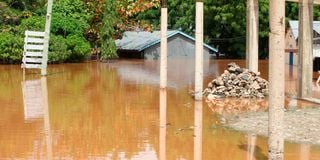
Homes submerged in floods at Mororo in Tana River County on November 10, 2023.
Abdulrakman Said, a Tana River resident, expresses concern about the unpreparedness of Kenyans for this season, particularly in lowland areas, where people are already facing the consequences.
The situation is the same across the country as residents are left to deal with the repercussions of the ongoing October, November, and December rains.
The Kenya Meteorological Department had in August echoed the World Meteorological Organization and IGAD’s Climate Prediction & Applications Centre (ICPAC) predictions, cautioning Kenyans to remain vigilant regarding the El Niño phenomenon expected in the country between October and December.
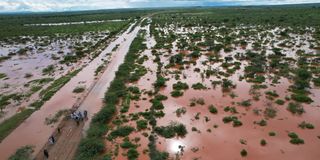
Flooding in Mandera County on November 20, 2023.
The weatherman had also indicated that the rains might extend to January 2024, with intense rainfall categorised as above average. It predicted landslides and flooding in previously affected areas, not just like the 1997–1998 rain season but in subsequent seasons like those experienced between October and December 2019.
El Niño is characterised by the unusual warming of surface waters in the Pacific Ocean, disrupting weather patterns. During El Niño, warm waters from the western Pacific shift eastward, leading to unusual weather events globally. Some regions may experience torrential rains and resultant flooding, while others endure prolonged droughts and heightened wildfire risks.
El Niño can also influence the intensity and frequency of hurricanes.
The most memorable El Niño occurrence in Kenya occurred between May 1997 and February 1998, and claimed at least 2,000 lives from unprecedented flooding. Despite the Kenya Meteorological Department’s warning about it nearly four months in advance, there was inadequate preparation. The country had neither a national plan nor policy for responding to flood disasters, even as most parts of the country received more than 100% above-normal rainfall.
With poor preparations, widespread and severe flooding wreaked havoc across the country, resulting in significant property damage, including homes. Many people drowned. The resulting floods heavily impacted urban centres due to blocked drainage systems, affecting transportation and various urban facilities.
The 1997-1998 stormwater destroyed an estimated 100,000 km of rural and urban roads and washed away various bridges. The raging waters displaced over 70,000 Kenyans, forced the closure of schools, triggered landslides in some areas, limited access to safe drinking water, and increased both waterborne and vector-borne diseases.

A woman walks in the rain at the IDP camp in Garissa town on November 8, 2023. More than 5000 residents have been displaced by the ongoing rains in Garissa county.
Former Nakuru Mayor John Kitilit recalls the lack of preparedness during that time, leaving various Nakuru County areas grappling with landslides and floods. Flooding cut off sections of the Nakuru–Eldoret highway, including the Eveready and Kolen roundabouts. Rhonda, Kaptembwo, and Mwariki were also severely affected.
Wheat farmers in the Rongai Sub-county suffered losses as their farms were soaked by excessive rainwater, making it impossible for combine harvesters or other machinery to operate in waterlogged soil.
This year’s index is lower than in 1997 but the Met urged Kenyans to keep their guard up and prepare responses to the fluctuating climatic conditions. “The rainfall will continue until this season is over. There will be breaks where some areas will experience a reduction, but it will continue,” Kenya Met Services Director Dr David Gikungu told NTV.
Flooding, especially from poor drainage, remains a significant threat, especially in urban areas where safe waste disposal remains a challenge.
The Nairobi Rivers Commission Vice Chairperson, Prof Elijah Biamah, says his team is working closely with various field teams under the Joint MultiAgency Operations. They are working with Nairobi County, the Water Resource Authority, the National Youth Service and Kenya Defence Forces to mobilise resources to desilt major waterways.
Emergency response teams and waste recyclers are included. Unlike prior crises where everyone worked in silos, Prof Biamah said they work as a unit in handling stormwater.
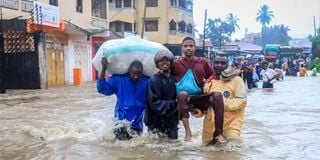
Pedestrians cross a flooded street following heavy rains at Kiembeni in Mombasa on November 17, 2023.
“We are working with three major thematic areas: stormwater drainage, sewage removal and solid waste disposal. Plastics carried to waterways during the rains make a big percentage of the solid waste we are removing,” Prof Biamah added.
Nairobi County Chief Officer for Environment Hibrahim Otieno says most of the identified hotspots have been cleared by the Green Army and teams from Nairobi Water and Sewerage Company (NWSC). He commends the ongoing works across the 17 sub-counties where youth were unblocking drainages to ensure the smooth flow of stormwater.
Mr Otieno pointed out some problematic areas like General Mathenge, which require more infrastructural installations. This is being addressed by installing new storm drains and building capacity to allow floodwater from neighbouring areas. He added that the county has deployed waste collection trucks, flushing units from NWSC, and the works sector to help unclog blocked culverts.
In Mombasa County, Governor Abdulswamad Shariff Nassir’s team is working with different groups and engineers to expand drainage systems. They have partnered with the Kenya Red Cross Society (KRCS) in activities such as unblocking sewerage systems.
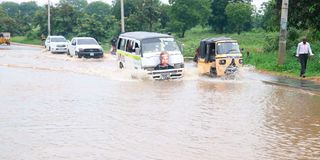
Motorists cross a flooded section of the Majaoni-Utange road in Mombasa County on November 17, 2023.
The Governor thanked the KRCS team for partnering to clear the drainages, saying, “We have cleared most drainage systems and are currently issuing contracts for the areas still uncleared.”
Former Acting Director of Kenya’s National Disaster Management Unit, Pius Masai Mwachi, says there’s a need for more action in the future. He advocates for reviewing preparedness plans, drawing from past El Nino experiences and a readiness for potential hazards like floods and increased crime.
As a former United Nations peace support operations mission police advisor, Mr Mwachi called for an evaluation of the city’s readiness, revisiting emergency and El Niño-specific contingency plans, and promoting innovative approaches such as rainwater harvesting.
According to Naftali Ndugire, a long-time practitioner of Environmental Economics and consultant, stormwater harvesting during El Niño benefits both the environment and humans. It aids in restoring aquatic ecosystems, reducing flash flooding, and providing an alternative water source for various uses.
Mr Ndugire emphasised that stormwater harvesting can have substantial direct and indirect effects, influencing water availability and existing infrastructure. Protecting biophysical systems associated with El Niño stormwater, such as rivers, lakes, wetlands and groundwater, is crucial for Kenyan cities and towns. This protection relies on proper land use planning and understanding the importance of surface and groundwater harvesting and protection by urban water users.






